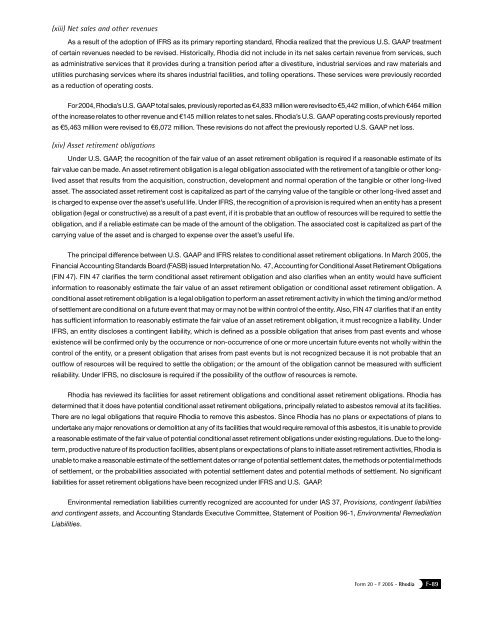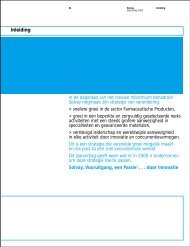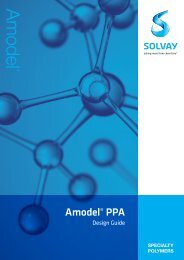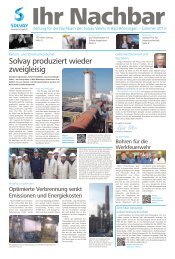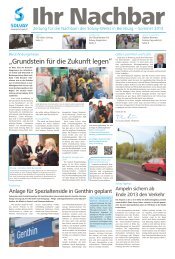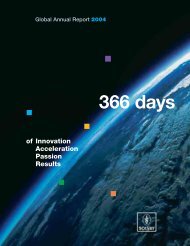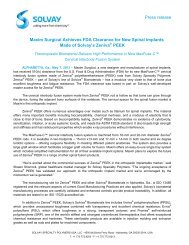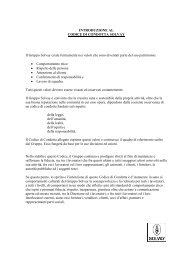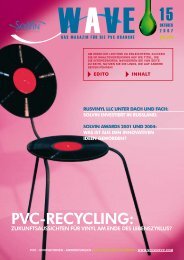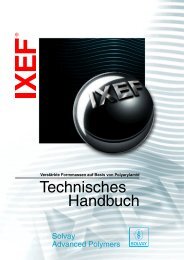Form 20-F 2005
Form 20-F 2005
Form 20-F 2005
Create successful ePaper yourself
Turn your PDF publications into a flip-book with our unique Google optimized e-Paper software.
(xiii) Net sales and other revenues<br />
As a result of the adoption of IFRS as its primary reporting standard, Rhodia realized that the previous U.S. GAAP treatment<br />
of certain revenues needed to be revised. Historically, Rhodia did not include in its net sales certain revenue from services, such<br />
as administrative services that it provides during a transition period after a divestiture, industrial services and raw materials and<br />
utilities purchasing services where its shares industrial facilities, and tolling operations. These services were previously recorded<br />
as a reduction of operating costs.<br />
For <strong>20</strong>04, Rhodia’s U.S. GAAP total sales, previously reported as €4,833 million were revised to €5,442 million, of which €464 million<br />
of the increase relates to other revenue and €145 million relates to net sales. Rhodia’s U.S. GAAP operating costs previously reported<br />
as €5,463 million were revised to €6,072 million. These revisions do not affect the previously reported U.S. GAAP net loss.<br />
(xiv) Asset retirement obligations<br />
Under U.S. GAAP, the recognition of the fair value of an asset retirement obligation is required if a reasonable estimate of its<br />
fair value can be made. An asset retirement obligation is a legal obligation associated with the retirement of a tangible or other longlived<br />
asset that results from the acquisition, construction, development and normal operation of the tangible or other long-lived<br />
asset. The associated asset retirement cost is capitalized as part of the carrying value of the tangible or other long-lived asset and<br />
is charged to expense over the asset’s useful life. Under IFRS, the recognition of a provision is required when an entity has a present<br />
obligation (legal or constructive) as a result of a past event, if it is probable that an outflow of resources will be required to settle the<br />
obligation, and if a reliable estimate can be made of the amount of the obligation. The associated cost is capitalized as part of the<br />
carrying value of the asset and is charged to expense over the asset’s useful life.<br />
The principal difference between U.S. GAAP and IFRS relates to conditional asset retirement obligations. In March <strong>20</strong>05, the<br />
Financial Accounting Standards Board (FASB) issued Interpretation No. 47, Accounting for Conditional Asset Retirement Obligations<br />
(FIN 47). FIN 47 clarifies the term conditional asset retirement obligation and also clarifies when an entity would have sufficient<br />
information to reasonably estimate the fair value of an asset retirement obligation or conditional asset retirement obligation. A<br />
conditional asset retirement obligation is a legal obligation to perform an asset retirement activity in which the timing and/or method<br />
of settlement are conditional on a future event that may or may not be within control of the entity. Also, FIN 47 clarifies that if an entity<br />
has sufficient information to reasonably estimate the fair value of an asset retirement obligation, it must recognize a liability. Under<br />
IFRS, an entity discloses a contingent liability, which is defined as a possible obligation that arises from past events and whose<br />
existence will be confirmed only by the occurrence or non-occurrence of one or more uncertain future events not wholly within the<br />
control of the entity, or a present obligation that arises from past events but is not recognized because it is not probable that an<br />
outflow of resources will be required to settle the obligation; or the amount of the obligation cannot be measured with sufficient<br />
reliability. Under IFRS, no disclosure is required if the possibility of the outflow of resources is remote.<br />
Rhodia has reviewed its facilities for asset retirement obligations and conditional asset retirement obligations. Rhodia has<br />
determined that it does have potential conditional asset retirement obligations, principally related to asbestos removal at its facilities.<br />
There are no legal obligations that require Rhodia to remove this asbestos. Since Rhodia has no plans or expectations of plans to<br />
undertake any major renovations or demolition at any of its facilities that would require removal of this asbestos, it is unable to provide<br />
a reasonable estimate of the fair value of potential conditional asset retirement obligations under existing regulations. Due to the longterm,<br />
productive nature of its production facilities, absent plans or expectations of plans to initiate asset retirement activities, Rhodia is<br />
unable to make a reasonable estimate of the settlement dates or range of potential settlement dates, the methods or potential methods<br />
of settlement, or the probabilities associated with potential settlement dates and potential methods of settlement. No significant<br />
liabilities for asset retirement obligations have been recognized under IFRS and U.S. GAAP.<br />
Environmental remediation liabilities currently recognized are accounted for under IAS 37, Provisions, contingent liabilities<br />
and contingent assets, and Accounting Standards Executive Committee, Statement of Position 96-1, Environmental Remediation<br />
Liabilities.<br />
<strong>Form</strong> <strong>20</strong> - F <strong>20</strong>05 - Rhodia<br />
F-89


